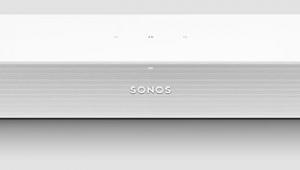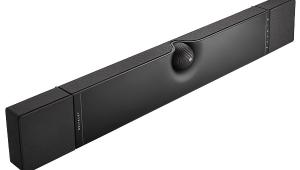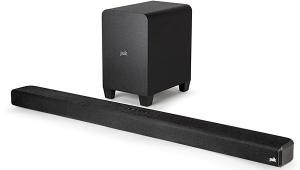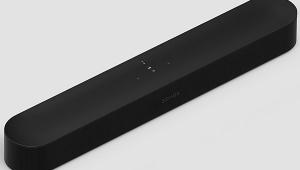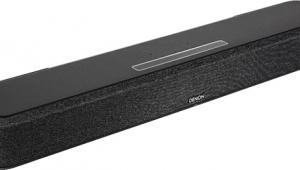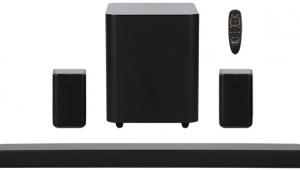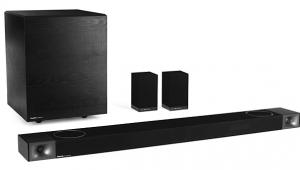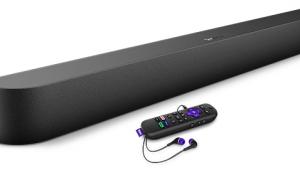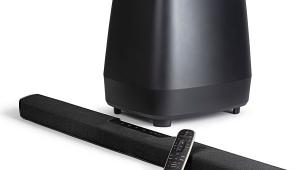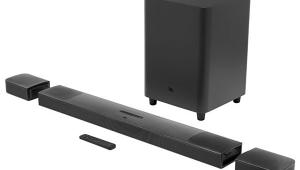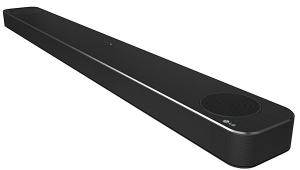Sonos Beam Wireless Soundbar Review

AT A GLANCE
Plus
Affordable price
Alexa voice control
Links with other Sonos speakers
Minus
More optimized for TV sound than music
Requires HDMI ARC for voice control of TV
THE VERDICT
Sonos’ compact, Alexa-enabled soundbar offers impressive performance for the price. All in all, a smart value.
Without knowing history, you might dismiss the Sonos Beam as just another budget soundbar dropped into a largely undistinguished field. But as with most things Sonos, this attractive yet intentionally non-descript oval is significant both for the company and the audio business. Sonos execs have long seen the living room television as the most logical gateway for their wireless multiroom music system. The idea, birthed with the Playbar soundbar back in 2013, was to build a Trojan horse whose primary function—fixing the awful sound quality of most flat-panel TVs—would also provide the impetus to introduce surrounds perhaps, maybe a subwoofer, and other wireless speakers scattered about the home for music.
After Playbar came 2017’s Playbase soundbase, offered for those who couldn’t wall-hang the admittedly large and awkward Playbar. The Playbase is a well-engineered piece capable of hitting low bass notes. Still, priced at the same $699 as the Playbar, it was hardly going to open the floodgates. Now comes the $399 Beam, whose big claim to fame is being among the first fully voice-integrated, Alexa-enabled “smart” soundbars to reach the market. With dimensions of just 25.6 x 2.7 x 3.9 (W x H x D), the Beam is also remarkably compact and easy to place in front of a TV or on a shelf below. It isn’t designed to hit the peak volume levels or low bass notes of its bigger siblings; Sonos recommends it for more moderate-sized rooms. But given its affordable price and outstanding audio performance with both movies and music, the company may have a hit on its hands. Let’s have a closer look and listen.
What's Inside Counts
The technology inside the Beam draws on what Sonos learned developing Playbase and last year’s Sonos One, the company’s first smart speaker. The small, high-excursion woofers used in array fashion in Playbase helped inform the design of the custom drivers for the Beam, which include four 2 by 3-inch elliptical woofers with aluminum cones, and a 0.75-inch silk dome tweeter. Two face forward, straddling the tweeter at dead center. The other two face out at an angle from each corner to help spread the soundstage. Three racetrack-shaped passive radiators, two on the front and one on the back baffle, further enhance bass. The Beam is technically a three-channel soundbar, but Sonos clarified that the system isn’t just operating discretely on the left, right, and center channel data; there’s some fancy routing of the information found in two-channel and multichannel signals (cross-cancellation, for example) to enhance the spatial characteristics, which are further optimized by the Trueplay setup (iOS device required) that identifies the room boundaries. As with the Playbar and Playbase, you can add a pair of Play:1s ($149 each), Play:3s ($249 each), or Sonos Ones ($199/each) for surrounds, or the SUB subwoofer ($699) for a full 5.1 system.

For something designed to blend with its environment, the Beam, which comes in black or white, looks sweet and offers solid build quality. The top panel has a power/status indicator that flashes when the Beam hears the Alexa wake-up call, and it houses capacitive touch controls that mimic those on the Sonos One: volume up/down, play/pause, and a privacy button (with its own LED) that allows users to turn off the five-microphone far-field array. Thanks to a Sonos system update a while back, the play/pause button can also be used to join the Beam to any Sonos speaker or group already playing elsewhere in the house. Just press and hold to stream the current program, or press again to cycle through multiple streams playing in different rooms.
Along with an optional Ethernet port and a setup button, the back panel offers something new for Sonos among its home theater products: an HDMI port for connection to your TV’s ARC (audio return channel) HDMI input. There’s no HDMI output or video pass-through; in most systems, you’ll connect your cable box and other sources to the TV’s alternate HDMI connections while reserving the ARC-enabled port for the Beam. This arrangement greatly simplifies setup. The Beam will be visible on the set’s CEC bus and automatically respond to the volume rocker on your existing TV or cable box remote.
Cooler still, it allows Alexa to control a variety of basic functions by voice, including turning the TV on and off, adjusting volume and mute, and flipping between TV sound or music on the Beam while the video image continues to play. (As an aside, the Sonos app also allows you to distribute TV sound to any Sonos speaker in the house, so you can keep an ear on the game while you’re, say, fixing a snack in the kitchen.) These functions worked fine on my aging Panasonic plasma TV.
Voice control further extends to any Alexa-enabled streaming media player. But I had only marginal success using an Amazon FireTV stick, even after reboots of all the devices and manual re-enabling of the Sonos skill set via the Alexa app. The Alexa assistant in the Beam could find and launch apps or specific programs, and it could search for movie titles or offer those from a particular director or actor. But transport commands like "Pause" weren't recognized ("Play" was, but only after I'd paused using the stick's microphone remote), nor were phrases like "back up 30 seconds" that otherwise worked fine from the FireTV remote. You may have better luck with your modern TV's CEC bus. All the other usuals you can do with Alexa via the Sonos skill set—ask questions, get the weather or restaurant recommendations, request your Steely Dan playlist from Spotify, etc.—worked like a charm. As of mid-June, this list also includes calling up your audio books from Audible. Voice-controlled music apps are limited to the Alexa-enabled services, but you can always route others to the Beam from the Sonos app.
- Log in or register to post comments



